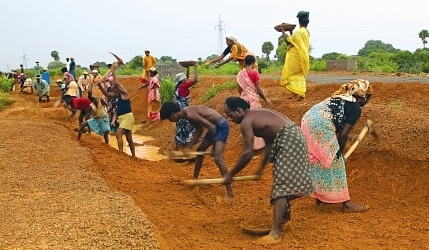Economy
Why India Could Shift From Guaranteed Boondoggle (NREGA) To Mininum Income For Poor
- A minimum basic income would lift many more people out of poverty than make-work schemes like MGNREGA (or NREGA) since this would be over and above what they would earn by way of normal employment – on the farms or elsewhere.

NREGA in action.
The ultimate logic of direct benefits transfers (DBT) – where people receive cash instead of indirect subsidies on items like gas, fertiliser or food - is minimum guaranteed income to citizens. India, with its JAM trio (Jan Dhan universal account, Aadhaar-established unique identity, and mobile delivered money), now has the delivery capability to experiment and move forward.
The idea of guaranteeing a minimum income to citizens has been gathering traction in some parts of the developed world, with Switzerland about to vote on 5 June in a referendum on it. The plan is to offer each citizen $30,000 of no-questions-asked minimum income per annum instead of welfare benefits. On current reckoning, the idea won’t pass muster with voters, but other countries, and even towns, have begun warming up to the idea. This report notes that Finland proposes to give each citizen 800 euros per month, and some cities in Netherlands are handing over $1,000 monthly through their local governments. Ontario in Canada is also mulling the delivery of basic income to citizens. With jobs not growing in a post-2008 world, capitalism is thinking delivering incomes instead.
Is India ready for it?
India’s major subsidies bill is already bloating beyond hope. In the 2016-17 central budget, subsidies get an outlay of around Rs 2,50,000 crore. State budgets also deliver huge subsidies, with the recently re-elected J Jayalalithaa government announcing a writeoff of farm loans and offering “free” electricity upto 100 units per user. Arvind Kejriwal is offering cheaper power and free water to many households.
If we accept a ceiling of two percent of GDP on central subsidies (the states can offer more), in 2016-17 some Rs 3,00,000 crore will be available for cash transfers. Assuming around 25 crore households in the country, this money is enough to deliver an annual income of Rs 12,000 per household – or Rs 1,000 per month.
If we restrict these payments to just half the population, the monthly payments can be doubled to Rs 2,000 per household – which still would not help clear the rural poverty line of Rs 32 per day recommended by C Rangarajan in 2014, but then this is only the basic income. The new poverty line would require household monthly incomes of Rs 4,800 for an average household of five.
NREGA, for example, touched only 4.2 crore people (less than one crore households) in 2015-16. Even though NREGA wages currently average at around Rs 200 per day (it varies from a low of Rs 167 per day in Bihar to a high of Rs 259 in Haryana), they are available for a maximum of 100 days per person per household. In short, NREGA is more about establishing a wage floor than about actually providing jobs or incomes to the poor. And, of course, it does not really create worthwhile assets. It is a boondoggle, a scheme that mostly generates useless work. A simple unemployment income would have done much better, without the charade of creating real assets.
Combining minimum incomes with genuine job-creating NREGA projects (where the scheme can be combined with real projects) may thus be better for poverty reduction than providing indirect subsidies where leakages are high.
Narendra Modi promised to double farm wages in five years. The way to do it is to use the power of delivering basic incomes through cash by eliminating indirect subsidies and offering cash to the farmer.
It is worth trying out the idea in pilot districts before taking it national. It’s an idea whose time has come, given the huge wastage in our subsidy system. JAM will be a great enabler.
The upside is clear: less corruption, and money going directly into the right pockets, even if the scheme is universalised. A bonus: the markets would then reflect real prices, as essentials would be sold at market prices. There would be less wastage, as people will buy only what they need instead of taking up what they are entitled to in rationing schemes.
Introducing ElectionsHQ + 50 Ground Reports Project
The 2024 elections might seem easy to guess, but there are some important questions that shouldn't be missed.
Do freebies still sway voters? Do people prioritise infrastructure when voting? How will Punjab vote?
The answers to these questions provide great insights into where we, as a country, are headed in the years to come.
Swarajya is starting a project with an aim to do 50 solid ground stories and a smart commentary service on WhatsApp, a one-of-a-kind. We'd love your support during this election season.
Click below to contribute.
Latest